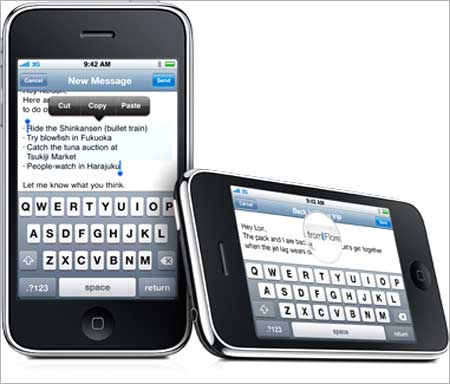|
| Help | |
| You are here: Rediff Home » India » Business » Pix |
|
 We've all been there: in a hurry and forced to hastily send SMSs on the run. Well, no longer. Forget the clumsy punch keys. And even the fancy touchscreens. The next big data entry user interface is air itself!
We've all been there: in a hurry and forced to hastily send SMSs on the run. Well, no longer. Forget the clumsy punch keys. And even the fancy touchscreens. The next big data entry user interface is air itself!
A new application called the PhonePoint Pen, created by engineering students at Duke University in North Carolina, USA, allows users to 'write' short notes in the air with their mobile phone. The notes are then sent automatically to a designated e-mail address.
Interestingly, two Indians are behind this leap forward. "By holding the phone like a pen, you can write short messages or draw simple diagrams in the air," said Sandip Agrawal, a Duke University electrical and computer engineering student, in a press release issued by the school.
"We're trying to get past the whole idea of typing on a keyboard or using a stylus to enter information into devices. Many people get discouraged with current phones and their small keys. As phones get smaller, this frustration will only grow. In the age of Twitter and micro-blogs, the speed at which you send information becomes more important," added fellow Indian Romit Roy Choudhury, an assistant professor of electrical and computer engineer at Duke, who acted as Agrawal's mentor for the PhonePoint Pen project.
A Romanian PhD computer science student at Duke, Ionut Constandache, worked alongside Agrawal and under Choudhury on the project. Many people get discouraged with current phones and their small keys. We think the application will be used by people creating short notes on the move - such as scrawling their car park bay for future reference. The potential uses are practically limitless."
So, how does the application manage its magic? Turns out, it harnesses the accelerometer technology that already exists in certain high-end phones and gadgets, like Apple's iPhone and Nintendo's Wii Remote. Accelerometers keep track of a device's movements and orientation. In the iPhone, for instance, the technology is used when the user turns the phone sideways, which causes the display screen to rotate from portrait to landscape mode.
For their work on the project, last week the team (Sandip in particular) was awarded with the inaugural Hoffman + Krippner Award for Excellence in Student Engineering at the 2009 Sensors Expo and Conference in Chicago.
Still, we may be getting ahead of ourselves. Although we're eager to ditch the stylus pens and QWERTY keyboards, the PhonePoint Pen still has much room for improvement. Right now, wannabe air-writers have to pause briefly between each letter, and cannot use a cursive script. Compared to current User Interfaces like punch keys and touchscreens, the PhonePoint Pen is actually quite a hassle.
But Choudhury and team expect to soon improve on their application, with better algorithms and accelerometers. Future versions of the PhonePoint Pen would even allow users to take a photo with their phone and then write a quick note on it, Constandache explained.
The application would become available for download in the next several months, according to Choudhury. As most new phone design incorporate accelerometer technology, the PhonePoint Pen application would not require changes to hardware, he added.
Image: The new iPhone 3G (S). | Photograph: Courtesy, Apple.com
| © 2009 Rediff.com India Limited. All Rights Reserved. Disclaimer | Feedback |
